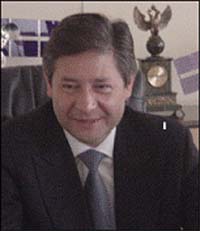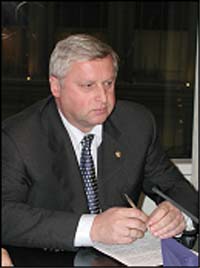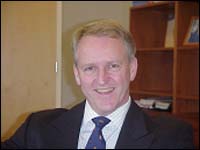 TELECOMMUNICATIONS - CELLULARS LEAD THE WAY
TELECOMMUNICATIONS - CELLULARS LEAD THE WAY |
Russian telecom, presided over by Leonid Reiman,
Minister of Communications and Informatization,
is developing in full strides these days and has
not perceptibly been harmed by the bursting of the
high-tech bubble in the United States and Europe.
Russian companies do not have such huge debts, as
do Western telecom operators. On average, telecom
companies muster about a 20 percent increase of
profits per year.

Leonid Reiman, Minister
of Communications and Informatization
True, Russia's telecommunications industry comprises
a mere 2 percent of GDP compared to 5 percent
on average in developed countries and the sector
is far from fully liberalized. Russia is reorganizing
its telecommunications by enlarging the regional
companies. During the first stage regional telecoms
merged their branches to lower operating costs
(up to 20-25% of overall costs are wages and other
labour expenses) and improve controllability.
Svyazinvest, a holding company that is 75 percent
owned by the state, controls more than 80 regional
operators. All in all, they run over 87 percent
of the national telecommunications infrastructure,
but generate only 51 percent of the industry's
revenues.
Still, the sector is far from stagnating with
an estimated growth for the 2002-2004 of 15 percent.
It may well result in the telecom services market
totalling roughly $10 billion annually by 2005.
These numbers are driven by the country's strong
economic growth and increase in demand for telecom
services. The supply of services in Russia is
1.5-2 times lower than one in Bulgaria and about
3 times below the Czech Republic. To meet the
rising demand, there is an urging need to create
open competition and increase the efficiency of
telecom operators. Consequently, the Industry
will look increasingly attractive to investors.
In fixed line telephony, Russia aims to increase
its numbers of installed fixed lines from 38.1
million to 48 million, equaling a penetration
rate of some 33 percent, by 2010. Next task is
changing the regulatory environment to smoothen
the progress of sector growth in the future. Legislation
is the first priority as the 1995 Communications
Law is severely outdated. A new law currently
under consideration will introduce universal service
to every part of Russia. 54,000 towns in Russia
do not have the luxury of phone access. Basic
telephone service will be available countrywide,
without hampering profit making by the telephone
operators. Liberalised interconnection to the
public switch telephone network can be expected
to result in faster growth of telecom services.
Minister Reiman of Communications and Informatization
points out: "Whilst studying the history
and results of reorganisation of telecommunications
companies in different countries, we came to the
conclusion that the most appropriate for Russia
will be the examples of the USA in the seventies
or Brazil in 1996. These countries created several
major companies to compete on the market, and
we have thus opted for this solution." The
Russians came to conclusion that Svyazinvest had
best been consolidated into seven pan-regional
companies (North-Western, Central, Volga, South,
Ural, Siberia and Far East). "One of the
main goals of telecommunications companies' consolidation
is exactly to improve investor attractiveness
through dramatic improvement of the business efficiency.
We need large investments to build out a modern
infrastructure and to meet the public demand for
traditional and advanced telecommunications services",
Ruben Amaryan, General Director of CenterTelecom,
one of the seven selected Russian telecommunications
companies, stresses.

Ruben Amaryan, General Director
of CenterTelecom
Full liberalization of telecommunications
in Russia, though, seems a fairly long way off.
A real opening to competition cannot be expected
before 2010, a date that is tied to Russia's WTO
commitments. Indicative is that the Ministry for
Communications and Informatization intends to
maintain Russia's long-distance national operator,
Rostelecom, as a monopoly for six years after
Russia's expected entry to the WTO in 2004. During
the six-year period, the Ministry plans to develop
the telecommunications market across Russia, and
will preserve some restrictions to liberalisation.
|
In order to reach European
standards, the Ministry estimates that Russia will
need to accumulate $33 billion in telecommunications
investment over the next 10 years. As there are
no clear-cut plans for state financing, this capital
must be extracted internally, from the capital market,
or from direct foreign investment. Total investments
into telecommunications in, for example, 2001 reached
22.2 billion rubbles or about $0.7 billion, which
is only a fraction of 1 percent of total investments
into basic assets of Russian enterprises.
Despite this forecast, foreign corporations have
all to gain in Russia's telecommunications. Eddie
Åhman, President of Ericsson Russia, notes,
"Since 2000, the times have been good both
for sales and investments. Even if the growth has
started from a fairly low level, it has still been
very positive looking at the trends: in the current
year, the number of new fixed lines was two times
higher than in 2001, the number of mobile subscribers
has doubled each year and will reach over seventeen
million subscribers by the end of 2002..."

Eddie Åhman, President
of Ericsson Russia
Estimated growth of the Russian telecommunications
industry as indicated in the Russian blueprint
for the development of its telecommunications
market:
| |
2000 |
2005est. |
2010est. |
| Number of phone lines (mln) |
31.2 |
36.9 |
47.7 |
| Number of mobile phones (mln) |
2.9 |
9.24 |
22.2 |
| Telephone density per 100 people (%) |
21.3 |
25.3 |
32.7 |
| Mobile phone density per 100 people (%) |
2 |
6.3 |
15.2 |
In mobile communications, there
is a trend that the cellular industry is growing
faster than the fixed line industry. In any case,
in Russia the development of cellular/GSM telephony
started somewhat later than in Western Europe,
and Russia has since been repeating the experiences
of other countries. As for the revenues, higher
numbers in the mobile sector is no surprise given
a relatively low penetration rate of fixed telephony
(23% in 2002), its outdated equipment and heavily
regulated tariffs. Russia foresees 22.2 million
cellular users by 2010. To reach this objective
there is a clear need to continue investments
in industry development. Thankfully, mobile operators
do not have the huge debts that Western companies
are facing. In addition, the share of citizens
having mobile phones is 2-3 times smaller than
in Eastern Europe. In the cellular industry, foreign
players should be able to find fertile soil to
work on, and indeed we see the interest from international
players such as Deutsche Telecom, Telia, Sonera,
and Tele2. Telenor, for example, decided to hook
up with local GSM giant, VimpelCom.
VimpelCom
is one of the pioneers in bringing mobile telephony
to the Russian population. In fact, the company
was also the first to bring a Russian GSM operator
to the New York Stock Exchange in 1996. The company
was a joint venture between a Russian individual
and an American company. The company achieved
excellent results in 1995, 1996, and 1997, after
the listing on NYSE. Despite a slump in 1998 that
saw the American partners move out of Russia,
and with a change from DAMPS to GSM technology,
VimpelCom has been able to expand strongly in
Moscow and is now rapidly networking its way around
Russia to form the biggest GSM network in the
world, at least, when one looks at the number
of kilometres or time zones (11). Significant
are the two strategic partners of VimpelCom, Telenor
from Norway with industrial experience and knowledge,
and Alfa group, which is a major financial industrial
player in Russia. Moreover, "while setting
up a national network we make sure that it has
one policy with the same procedures and business
processes, a unified strategy throughout the country
with the same technical solutions, the same billing
system, the same customer service and, of course,
the same brand", stresses Jo
Lunder, CEO of VimpelCom / Beeline.

Jo Lunder, CEO of VimpelCom
/ Beeline
Next to the gradual introduction
of new services, such as messaging, voice mail
and caller ID, and packet switched radio-technology,
key has been that "the Beeline brand is one
of the most recognised brands in the country.
VimpelCom was the first company in Russia that
realised the strength and the importance of the
brand. The Beeline brand has been linked to innovation
and strong performance for many years", something
Lunder prides himself in. Indeed, Beeline is one
of the well-recognized brands in the country and
this will surely help the company reach its objective
of 30% of the national market in three to four
years.
|

